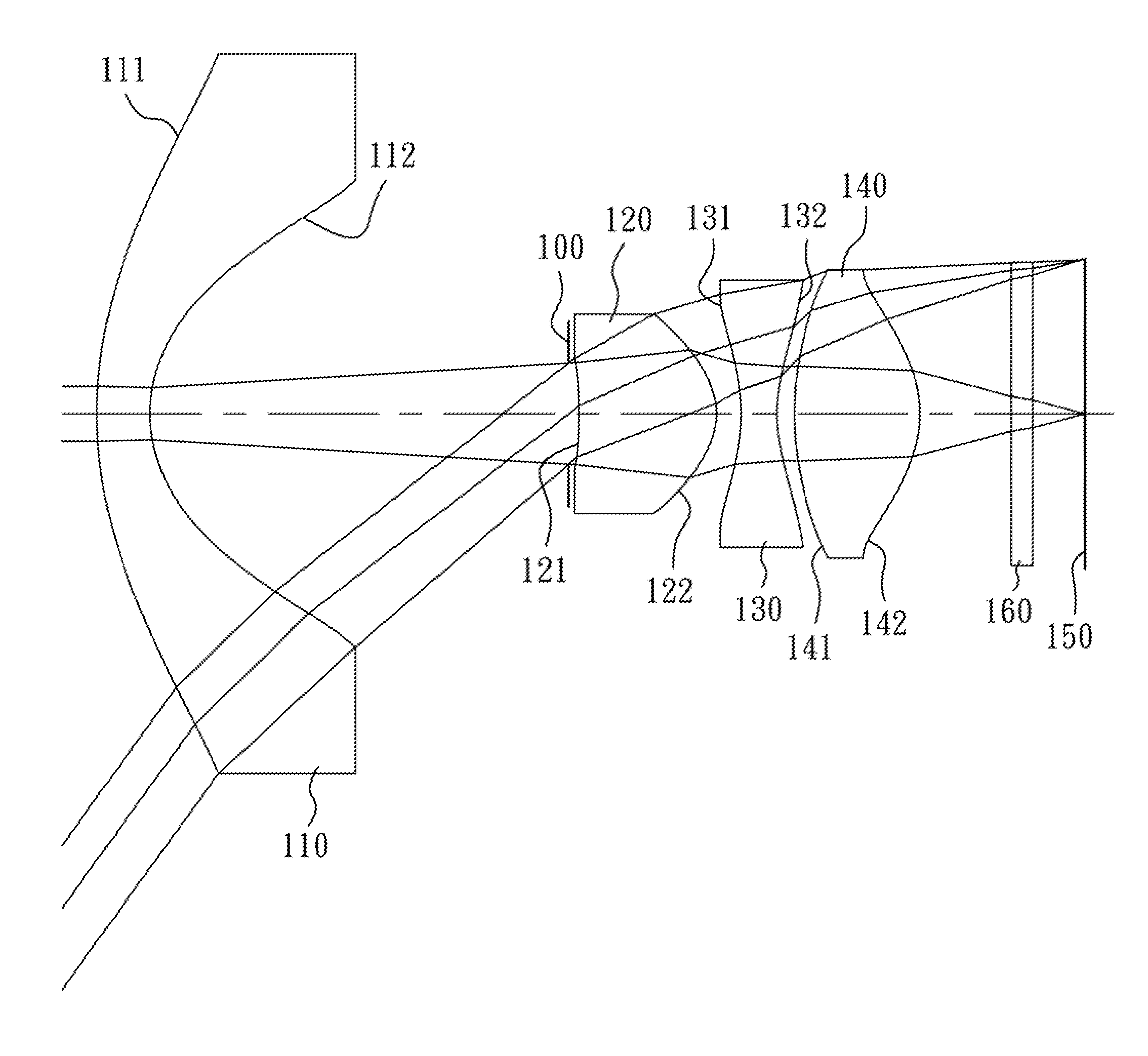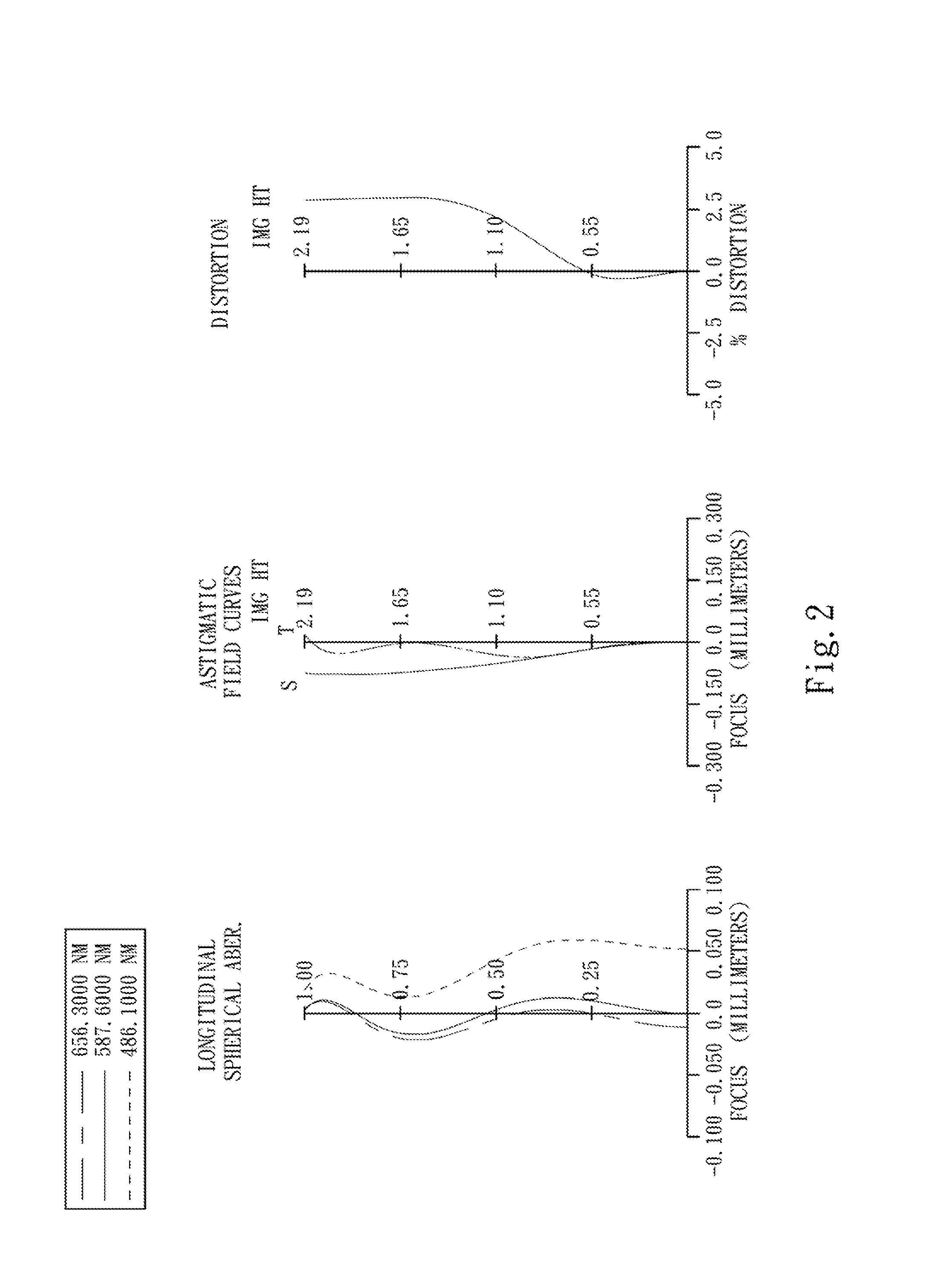Image capturing lens system
a technology of image capturing and lens system, which is applied in the field of image capturing lens system, can solve the problems of inability to produce high-quality images, insufficient degree of freedom in setting system parameters, and the length of the total optical track of the lens structur
- Summary
- Abstract
- Description
- Claims
- Application Information
AI Technical Summary
Benefits of technology
Problems solved by technology
Method used
Image
Examples
first embodiment
[0060]FIG. 1 is a schematic view of an image capturing lens system according to the first lens embodiment of the present disclosure. FIG. 2 shows spherical aberration curves, astigmatic field curves and a distortion curve of the image capturing lens system according to the In FIG. 1, the image capturing lens system includes, in order from an object side to an image side, the first lens element 110, an aperture stop 100, the second lens element 120, the third lens element 130, the fourth lens element 140, an IR (infrared) cut filter 160 and an image plane 150.
[0061]The first lens element 110 with negative refractive power has a convex object-side surface 111 and a concave image-side surface 112, and is made of plastic material. The object-side surface 111 and the image-side surface 112 of the first lens element 110 are aspheric.
[0062]The second lens element 120 with positive refractive power has a concave object-side surface 121 and a convex image-side surface 122, and is made of pl...
second embodiment
[0087]FIG. 3 is a schematic view of an image capturing lens system according to the second lens embodiment of the present disclosure. FIG. 4 shows spherical aberration curves, astigmatic field curves and a distortion curve of the image capturing lens system according to the In FIG. 3, the image capturing lens assembly includes, in order from an object side to an image side, the first lens element 210, an aperture stop 200, the second lens element 220, the third lens element 230, the fourth lens element 240, an IR cut filter 260 and an image plane 250.
[0088]The first lens element 210 with negative refractive power has a convex object-side surface 211 and a concave image-side surface 212, and is made of plastic material. The object-side surface 211 and the image-side surface 212 of the first lens element 210 are aspheric.
[0089]The second lens element 220 with positive refractive power has a concave object-side surface 221 and a convex image-side surface 222, and is made of plastic ma...
third embodiment
[0096]FIG. 5 is a schematic view of an image capturing lens system according to the third lens embodiment of the present disclosure. FIG. 6 shows spherical aberration curves, astigmatic field curves and a distortion curve of the image capturing lens system according to the In FIG. 5, the image capturing lens assembly includes, in order from an object side to an image side, the first lens element 310, an aperture stop 300, the second lens element 320, the third lens element 330, the fourth lens element 340, an IR cut filter 360 and an image plane 350.
[0097]The first lens element 310 with negative refractive power has a convex object-side surface 311 and a concave image-side surface 312, and is made of plastic material. The object-side surface 311 and the image-side surface 312 of the first lens element 310 are aspheric.
[0098]The second lens element 320 with positive refractive power has a concave object-side surface 321 and a convex image-side surface 322, and is made of plastic mat...
PUM
 Login to View More
Login to View More Abstract
Description
Claims
Application Information
 Login to View More
Login to View More - R&D
- Intellectual Property
- Life Sciences
- Materials
- Tech Scout
- Unparalleled Data Quality
- Higher Quality Content
- 60% Fewer Hallucinations
Browse by: Latest US Patents, China's latest patents, Technical Efficacy Thesaurus, Application Domain, Technology Topic, Popular Technical Reports.
© 2025 PatSnap. All rights reserved.Legal|Privacy policy|Modern Slavery Act Transparency Statement|Sitemap|About US| Contact US: help@patsnap.com



